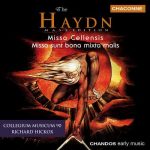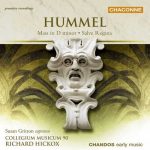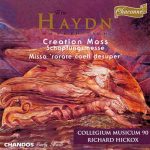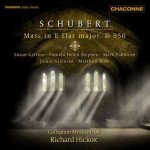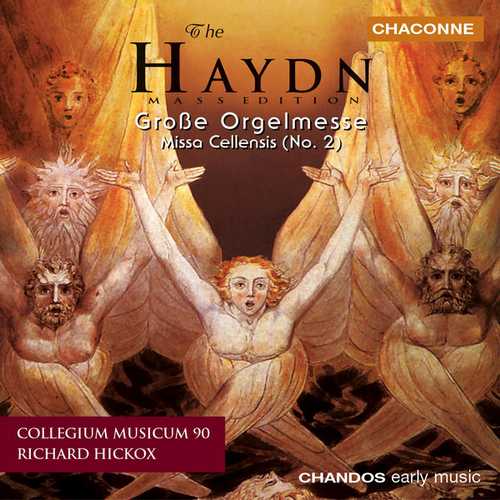

Composer: Franz Joseph Haydn
Performer: Susan Gritton, Louise Winter, Mark Padmore, Ian Watson, Stephen Varcoe
Orchestra: Collegium Musicum 90
Conductor: Richard Hickox
Format: FLAC (tracks)
Label: Chandos
Catalogue: CHAN0674
Release: 2002
Size: 895 MB
Recovery: +3%
Scan: yes
Mass No. 5 in E flat major, Hob.XXII:4, “Missa in honorem BVM”, “Missa Sancti Josephi”, “Grosse Orgelsolomesse”
01. Kyrie
02. Gloria: Gloria in excelsis Deo
03. Gloria: Gratias agimus tibi
04. Gloria: Quoniam tu solus Sanctus
05. Credo: Credo in unum Deum
06. Credo: Et incarnatus est
07. Credo: Et resurrexit
08. Sanctus
09. Benedictus
10. Agnus Dei
Mass, Hob. XXII: 8 in C major – Missa Cellensis ‘Mariazellermesse’
11. Kyrie
12. Gloria: Gloria in excelsis Deo
13. Gloria: Gratias agimus tibi
14. Gloria: Quoniam tu solus Sanctus
15. Credo: Credo in unum Deum
16. Credo: Et incarnatus est
17. Credo: Et resurrexit
18. Sanctus
19. Benedictus
20. Agnus Dei
This concluding issue in Richard Hickox’s prize-winning Haydn Mass series follows a similar pattern to earlier discs, offering exhilarating performances which wear their period style lightly. Gardiner for Philips is by a fraction the more crisply incisive, with pinpoint attack and clean textures: Hickox generally prefers slightly broader speeds, with full, immediate sound, more clearly bringing out the joy of Haydn’s inspiration as well as the drama.
Both of these Masses are relatively neglected, even on disc. The Great Organ Mass, dating from 1768-9, seems not to have been composed for a special occasion, but, exceptionally, because Haydn wanted to write it. It’s a distinctive work, both in its choice of key, E flat, rare for a Mass of the time, and for replacing oboes in the orchestra with two cor anglais.
The role of the organ is far more important, though; its Baroque figuration attractively decorative, while the Benedictus includes a concertante organ part, accompanying the quartet of soloists. Choosing light registration, Ian Watson produces delightful sounds throughout, with delicate organ decorations set in contrast with the relatively plain choral writing. As in the rest of the Hickox series, the singing and playing of Collegium Musicum 90 is most stylish.
Hickox has a special relish for Haydn’s rhythmic exuberance, as in the syncopated Amens in the Sanctus and the robust 6/8 rhythms of the ‘Dona nobis pacem’ at the very end.
The Mariazeller Mass, written much later in 1782, was the last Mass setting that Haydn composed before the final six masterpieces, and already points forward. As in those late Masses, the Kyrie is in a compressed sonata form: a slow introduction leads to a vigorous Allegro, with the ‘Christe eleison’ as the development section.
Clearly, Haydn was already thinking of his Mass settings in symphonic terms, with striking keychanges also relating to Haydn’s symphonic writing.
Even more than in the Great Organ Mass, Hickox brings out the vitality of the writing, as in the extraordinary ‘Dona nobis pacem’ at the end, so wildly syncopated it’s almost jazzy. A splendid culmination to an outstanding series.
